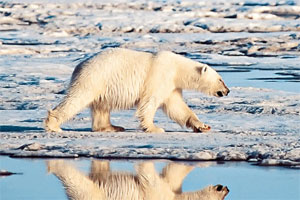In the tundra as well as the taiga, the average temperature often does not surpass 0ºC. Due to this, many of the animals that inhabit these areas must adapt themselves and their functions to survive these conditions.
Hibernation is one of the mechanisms used by homeothermal animals (which maintain a constant temperature) in order to survive the low temperatures of the extreme zones they live in, especially in winter. Energy sources (the sun and foods) become scarce during this last period, and therefore, animals seek the most efficient ways to survive.
Due to this, some migrate to warmer areas, others enter a period or torpor and yet others resort to hibernation. Hibernation is a series of changes in the normal physiological processes performed by animals.
Generally, many vital functions become so slow they almost disappear: their heart and respiration lower their frequencies to almost imperceptible levels, and body temperature in some cases goes over the zero degree barrier (animals manage to almost equal their thermal levels to the external environment).
A series of chemical reactions (metabolic) even activate inside the animals in order to prevent them from dying of cold. The most usual conduct animals take up is to eat a lot during the fall, before the arrival of the most extreme season.
This way, they manage to accumulate enough fat (fatty tissue), which will serve as a reserve for the months in which they will not eat. Although they survive, most of them lose a great amount of weight.
Vital camouflage
Some Arctic animals also have the ability to camouflage themselves in the white landscape that surrounds them. This process is mainly performed during winter, because some brushes develop during the summer season, which eases hiding for the predator or the prey.Conditions change drastically in winter.
Any trace of protective vegetation disappears, reason for which camouflage becomes necessary for many of the species. It is a matter of survival for the Arctic hare (Lepus arcticus), which, thanks to light variations, can “dress” in white and thus prevent localization by predators like the Arctic fox. However, nature is prepared for the relationships between primary and secondary consumers to continue balanced, reason for which the fox (Canis lupus) also has this ability, which enables it to stalk its prey.
The same thing happens with the Polar bear (Ursus maritimus) and some seals. The latter’s young can easily be confused for a piece of ice, becoming free form the threat of their most faithful predator. However, the polar bear also acquires a whiter tone, being able to slyly stalk its prey without the latter being able to react in time. This way, camouflage is a never ending game of hide-and-seek in which the most skillful manages to survive.








 Termina la Guerra de Corea
Termina la Guerra de Corea